MISCELLANEOUS
Fibulae pins used to fasten Chitons and Chlamys and for decoration analog to modern safety pin. From the 7th century BC often made of gold and elaborately decorated along a catch plate with animals, a sphinx etc (gold pin (fibula) with 2 winged sphinxes and a lion's head Greek, seventh-fifth century BC)
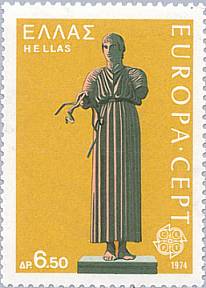
The Charioteer of Delphi and details of his Chiton, a version called xystis used by all chariot drivers during the race. It spans the whole body all the way to his ankles. It is fastened high at the waist with a plain belt. Two straps cross high at his upper back and round his shoulders keep the chiton fixed during the race.
Women with a girdle
Zone “Girdle” A narrow cord or strip of leather worn over the shoulders, under the arms and tied at the waist or simply around the waist and/or hips as a means of controlling the fullness of the Chiton. The famous Charioteer statue is girded using the first means. Zone, worn both by men and women just above the hips, to be distinguished from the second girdle worn by women just under the breast. The zone kept the chiton in place and furnished the means for regulating its length, since it could be drawn under the girdle so as to leave the feet unimpeded. The girdles of women were often simple cords, but they might be elaborate and handsomely elaborated. The soldiers girdle commonly caller Zostir, was a substantial belt of metal, or of leather plated with metal, worn about the loins to secure the lower part of the cuirass and fastened by hooks. Phrases: elabon tis zonin ton... "grasped some by the girdle" the sign among Persians that one had been condemned to death or eis zonin dedomenai "given for girdle money" as we should say, pin money. (White and Morgan, illustrated dictionary of Xenophon's Anabasis)
Strophion / Rom. Cestus Girdle

Mycenaen bronze brooches

Ancient Greek Pins for Clothes
Skeiadeion
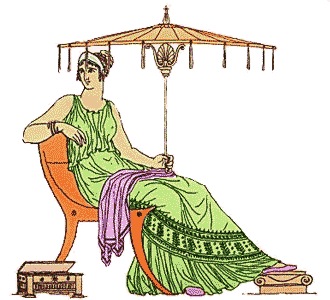
Woman with a “skeiadion” an umbrella.
Umbrellas are known at least since 2400 BC (image discovered in the Mesopotamia region), in Cyprus since 1000 BC.
William Sangster, Umbrellas and their History:
In Greece, as Becker tells us in his "Charicles," the Parasol was an indispensable adjunct to a lady of fashion. It had also its religious signification. In the Scirophoria, the feast of Athene Sciras, a white Parasol was borne by the priestesses of the goddess from the Acropolis to the Phalerus. In the feasts of Dionysius (in that at Alea in Arcadia, where he was exposed under an Umbrella, and elsewhere) the Umbrella was used, and in an old has-relief the same god is represented as descending ad inferos with a small Umbrella in his hand, like Vishnu before mentioned.
There was also another festival in which they appeared, though without any mystical signification. In the Panathenaea, the daughters of the Metoeci, or foreign residents, carried Parasols over the heads of Athenian women as a mark of inferiority,
"They compelled the maidens of the Metoeci to act a umbrella-bearers in the processions."
Its use seems to have been confined to women. In Pausanias there is a description of a tomb with the figure of a woman, "And by her stood a female slave, bearing a parasol."
Aristophanes seems to mention it among the common articles of female use , Thesmoph , 821. "For now our loom is safe, our weaving-beam, our baskets and umbrella."
It occurs frequently on vases, and is in shape like that now used. It could be put up and down. Arist. Eq. , 1347. "But your ears, by Jove, are stretched out like a parasol, and now again shut up."
Which the Scholiast explains, "Are opened and shut as need requires". For a man to carry one was considered a mark of effeminacy, as appears from the following fragment of Anacreon:, Athenaeus, lib. xii., "He carries an ivory parasol, as women do."
Plutarch makes Aristides speak of Xerxes as sitting under a canopy or Umbrella looking at the sea-fight
Plut. Therm., "Sitting under a golden canopy." and of Cleopatra in like manner Plut. Anton., "Under a gold-wrought canopy."
----------------------
Kynodesme (“dog leash”)
A leather strip (a string around the foreskin “akroposthion” ) binding the penis (called by the Athenians kyon or dog). Used for example by athletes who running nude can be painful. An image of an athlete with a kynodesme
Herakles, Dyes and Pigments

The discovery of the purple, Theodoor van Thulden
According to Julius Pollux (Onomasticon I, 45-49), writing in the second century AD, purple dye was first discovered by Herakles, or rather, by his dog, whose mouth was stained purple from chewing on snails along the Levantine coast, the area most famous in antiquity for its purple dye (A nymph called Tyros observed the purple colour: charmed at first sight with the beauty of the colour, she said that she would see Hercules no more, till he brought her a suit dyed the same colour. Hercules, to satisfy his mistress, collected a great number of these shells, and succeeded to stain a robe of the colour the nymph had demanded. J. C. Lettsom). Palaephatus (De Incred 62) also attributes the discovery of purple dye to Herakles and locates it at Tyre in the mid-second millennium B.C. King Phoenix received a purple-dyed robe from Herakles and decreed that the rulers of Phoenicia should wear this colour as a royal symbol. Brendan Burke Early purple dye production on Crete
The story is also described by John Malalas in his Chronographia, who considers Heracles "the philosopher", from Tyros as the inventor:
Ἐν δὲ τοῖς χρόνοις τῆς βασιλείας τοῦ Φοίνικος ἦν Ἡρακλῆς ὁ φιλόσοφος, ὁ λεγόμενος Τύριος, ὅστις ἐφεῦρε τὴν κογχύλην· ἐωριζόμενος γὰρ ἐπὶ τὸ παράλιον μέρος τῆς Τύρου πόλεως εἶδε ποιμενικὸν κύνα ἐσθίοντα τὴν λεγομένην κογχύλην, ὅπερ ἐστὶ μικρὸν εἶδος θαλάσσιον κοχλιοειδές, καὶ τὸν ποιμένα, νομίζοντα αἱμάσσειν τὸν κύνα, λαβόντα ἀπὸ τῶν προβάτων πόκον ἐρέας καὶ καταμάσσοντα τὸ καταφερόμενον ἐκ τοῦ στόματος τοῦ κυνὸς καὶ βάπτοντα τὸν πόκον. ὁ δὲ Ἡρακλῆς, προσεσχηκὼς μὴ εἶναι αὐτὸ αἷμα, ἀλλὰ βάμματος παραξένου ἀρετήν, ἐθαύμασε·
The Phoenicians actually is a name given by the Greeks to the people called the Sidonians according to one interpretation from the greek word "Phoinos" i.e. dark red probably due to the color of the textile they produced.
gnafeus γναφεὺς (a cleaner of clothes) καὶ μετεμορφώθη ἔμπροσθεν αὐτῶν, καὶ τὰ ἱμάτια αὐτοῦ ἐγένετο στίλβοντα λευκὰ λίαν, οἷα γναφεὺς ἐπὶ τῆς γῆς οὐ δύναται οὕτως λευκᾶναι (And his raiment became shining, exceeding white as snow; so as no fuller on earth can white them) Mark 9.3, New Testament
Epinetron (Επίνητρον)- a pottery thigh protector that women wore over her leg when roving wool. Images: 1 , 2
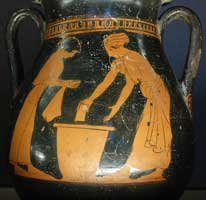
JEWELRY
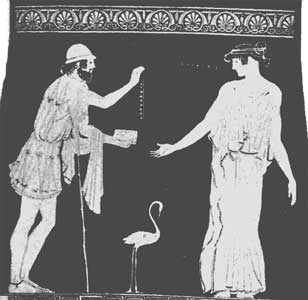
Polynices offers Eriphyle a necklace, 5th century BC red figure Pelike
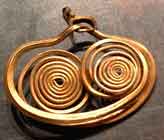

Cabinet des Médailles, BNF, Paris, France, Gold earring with filigrane decoration. Taras, third quarter of the 4th century BC.
Credit line De Luynes bequest, 1862 , Accession number Luynes 480
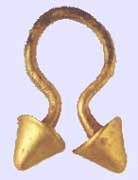


Ancient Greece: Ear Ring, part of a Diadem, Bracelet (Hellenistic period)
Greek Jewelry, Pontika (Ukraine)
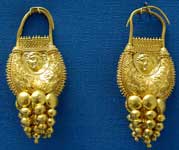
Dyfri Williams, Jack Ogden, Greek Gold: Jewelry of the Classical World , Metropolitan Museum of Art
John Boardman, Greek Gems and Finger Rings: Early Bronze to Late Classical
INFLUENCE OF ANCIENT GREEK FASHION


Left image: Bodhisattva (India) with a Hellenistic influenced Buddha as a result of the expedition of Alexander the Great. See Greco-Buddhism , Evolution of the Buddha Image b) Right Image: “The American Zeus” George Washington (Horatio Greenough, 1840) also with an ancient Greek outfit, a mixture of Raphael's Plato and Demosthenes, actually it shows Washington based on the colossal Zeus of Olympia statue as Zeus the Lawgiver. The seminude Washington as expected shocked many Americans. “When Greenough carved his large statue of George Washington in the national Capitol, he omitted the drapery on the upper part of the body, obviously with the intention of drawing the attention of the spectator away from the dress to the person who wore it. He clearly followed in this respect the practices of the Greeks, and more especially the pattern set by Pheidias in his colossal Zeus in Olympia. The Greeks might omit the drapery with impunity, for they were as a race intensely fond of the nude. Greenough, imitating them in the face of very pronounced racial and religious prejudices against the nude, committed the unpardonable mistake of copying not the spirit of a past art but its accidental expression. Instead of accomplishing his end, therefore, by omitting the drapery, he achieved the opposite, for the drapery is "conspicuous by its very absence." Edmund von Mach, Greek Sculpture
Why is Napoleon depicted with his hand in his coat?
Aeschines (a Greek orator) postulated that speaking with one's arm outside the toga was considered ill-mannered. Miller says that the hidden hand was a feature of some statues of the ancient Greeks and Romans and that later painters based their poses on classical models. A number of textbooks on oratory published in the eighteenth century, following Aeschines, recommended this gesture. Although Miller doesn't mention it, it is possible that the great French actor Talma, who reportedly trained Napoleon in Imperial comportment, may have been familiar with these works. Tom Holmberg http://www.napoleonseries.org/index.cfm

Some stories about Greek fashion
Ah! I do not know how to use fine clothing! The other day, when cramming myself with fried fish, I dropped so many grease spots that I had to pay three obols to the cleaner. Aristophanes in Wasps: - Philocleon says that he drops fried fish grease all over his clothes and must pay three obols to the cleaners for their removal.
Aeschines, Speech, describes the clothing of Demosthenes as soft and pretty. He claims that a jury could not tell whether a man or a woman would wear these clothes.
Euripides, Alcestis tells us that the style of clothing changed as a person grew older. This is apparent from the remark in this text that a woman’s age can be told from her dress and adornments.
Xenophon in Economics says that one day a husband notices that his wife has painted her face white with white lead, had used alkanet juice as rouge on her cheeks and “she was wearing boots with thick soles to increase her height.”
Herodotus, in History tells us the story of how and why women’s dress changed from Doric to Ionian (that does not require pins) because they had used their broach pins to kill a man. He was a messenger of bad new of a lost battle where only he survived: According to the Athenians, it was the god who destroyed their troops; and even this one man did not escape, for he perished in the following manner. When he came back to Athens, bringing word of the calamity, the wives of those who had been sent out on the expedition took it sorely to heart that he alone should have survived the slaughter of all the rest;—they therefore crowded round the man, and struck him with the brooches by which their dresses were fastened each, as she struck, asking him where he had left her husband. And the man died in this way. The Athenians thought the deed of the women more horrible even than the fate of the troops; as however they did not know how else to punish them, they changed their dress and compelled them to wear the costume of the Ionians. Till this time the Athenian women had worn a Dorian dress, shaped nearly like that which prevails at Corinth. Henceforth they were made to wear the linen tunic, which does not require brooches. Herodotus Book 5
Sophocles in Oedipus Tyrannus says that Oedipus uses Jocasta’s broaches to blind himself.
Xenophon in Anabasis says that in battle he uses his best clothes so as in case he gets killed to be at least well dressed.
Telesilla, a poetess dressed in men's clothes who rallied the women of the besieged city of Argos with war hymns and chants and repelled an attack upon the city of Argos. The festival Endymatia, in which men and women exchanged clothes, celebrated the heroism of the women.
Demetrios Poliorcetes once posed as Zeus with a chlamys with golden stars and the twelve signs of the zodiac.(Zeus often is shown with a blue mantel probably a symbol representing the sky)
Euclid of Megara, the philosopher: The Athenians had forbidden the Megarans to enter their region on pain of death. Euclid of Megara, a friend and student of Socrates, didn't let that keep him from visiting his teacher. He went at night, clothed in gaudy women's clothing, from Megara to Athens, and in the morning, before it was day, went his 20,000 steps back home again. (Moses Mendelssohn THE LIFE AND CHARACTER OF SOCRATES)
Batalus, the flute player from Ephesus, appeared on the stage with women's shoes for which he was mentioned in a comedy of Antiphanes
Quotations
What spirit is so empty and blind, that it cannot recognize the fact that the foot is more noble than the shoe, and skin more beautiful that the garment with which it is clothed?
Michelangelo
CLEONICE But how should women perform so wise and glorious an achievement, we women who dwell in the retirement of the household, clad in diaphanous garments of yellow silk and long flowing gowns,decked out with flowers and shod with dainty little slippers?
LYSISTRATA Ah, but those are the very sheet-anchors of our salvation-those yellow tunics, those scents and slippers, those cosmetics and transparent robes. Aristophanes Lysistrata
Greek dress was in its essence inartistic. Nothing should reveal the body but the body. Oscar Wilde
Demades, one of the demagogues, publicly taunted Phocion, saying: "Let us simply adopt the whole Spartan constitution here in Athens." To this, Phocion replied: "You, with your perfume and your fancy clothes, are the perfect man to speak in favor of such a proposal." Plutarch, Phocion
Miletus imported wool from the local Anatolian countryside, ran it through textile mills, built an impressive clothing industry, and sowed 80 colonies from the Black Sea and Egypt to Italy. With her sixty colonies to the north, Miletus traded clothware for flax, timber, fruit and metals. What's more, Miletus was part of a web of hundreds of additional Greek colonies (including those of relative backwaters like a town called Athens). These were perched, as Plato said, "like frogs" on the shores of Europe's and Western Asia's central seas. So Miletus' commerce stretched from Russia to France, Spain and North Africa, and it sucked in goods from the distant east as well. According to Will Durant, Miletus' resulting wealth became "a scandal" throughout the Mediterranean Howard Bloom Greece, Miletus and Thales - The Birth of the Boundary Breakers - 3,000 BC to 550 BC.

At seven years of age, I carried the sacred vessels; at ten, I pounded barley for the altar of Athene; next, clad in a robe of yellow silk, I played the bear to Artemis at the Brauronia; Aristophanes, Lysistrata
Mythological stories
Omphale and her slave Hercules, Francois Lemyone, 1724. Hercules is punished to wear women's clothes, while Omphale wears his Nemean Lion skin.
IMAGES
statue of a young woman wearing a peplos; Roman copy of Hellenistic original
detail, head and upper torso. Rome, Museo Montemartini (Capitoline Museums). Credits: Barbara McManus, 2003
so-called “Dancers of Herculaneum”, 5 statues of women wearing the Doric peplos
a group of life-sized bronzes with inlaid eyes that were adapted Roman copies of originals from the fifth century BCE, all found in the Villa dei Papiri in Herculaneum.
statue 1; detail, fastening peplos at shoulder
statue 2, statue 3; statue 4; statue 5
Naples, National Archaeological Museum. Credits: Barbara McManus, 2003
gold pin (fibula) with 2 winged sphinxes and a lion's head Greek, seventh-fifth century BCE, London, Victoria & Albert Museum. Credits: Barbara McManus, 2002
http://www.perseus.tufts.edu/cgi-bin/image?lookup=1992.11.0050&type=vase with a chiton decorated with crosses, boots with curled flaps, and himation with striped border hung over his arms. His long hair is bound up in a heavy bunch at the nape of his neck by a fillet wound twice about his head and tied at the back
Women spinning images

A relief from a Greek colony in Calabria, a woman opens a case probably with clothes, National Museum of Reggio Calabria, 490-450 BC (Image from a Greek school Project)
See also:
The Kanephoros and Her Festival Mantle in Greek Art, Linda Jones Roccos
See also:
Fashion in Egypt
BOOKS
Goddess: The Classical Mode; By Harold Koda exhibition catalogue for the Metropolitan Museum of Art costume institute. It shows the influence of ancient Greek and Roman fashion in more modern times on women's costume
| Ancient Greece
Science, Technology , Medicine , Warfare, , Biographies , Life , Cities/Places/Maps , Arts , Literature , Philosophy ,Olympics, Mythology , History , Images Medieval Greece / Byzantine Empire Science, Technology, Arts, , Warfare , Literature, Biographies, Icons, History Modern Greece Cities, Islands, Regions, Fauna/Flora ,Biographies , History , Warfare, Science/Technology, Literature, Music , Arts , Film/Actors , Sport , Fashion --- |


